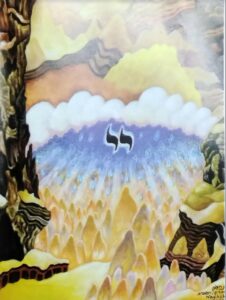בס”ד
By Rabbi Moshe Goodman, Kollel Ohr Shlomo, Hebron
As One Person with One Heart

In this painting we find an emphasis on unity as we find in the Haftora of Vayigash that talks about Yehezkel’s vision that the trees of of the Kingdoms of Yehuda and Yisrael willl be united. All this parsha carries a theme of unity as it says that Israel encamped – in singular usage “vayihan” (and not “vayahanu”) – which our Sages interpret to mean that “they encamped as one person united with one heart.” The two trees/branches in this painting also look like antlers of one animal which also turn into shofars, a symbol of repentance. This may also allude to the idea that to bring unity both sides should make an effort to curb their evil impulse in repentance. To complement this unity theme it seems we also see other dualisms in this painting that are united together in harmony. For example, there are two birds at the center facing each other, as a sign of peace and unity. There are yet two other birds in flight carrying olive branches like the dove of Noah which by so doing symbolized an era of peace and tranquillity after the Flood. The middle “branch/stem” has a Menora-looking sprout with dual “shins” on each side of the Menora.
Similar to these shins we see a shin-looking candelabrum at the top of the painting. The three points of this Shin at the top, asides from alluding to God’s Name Shaddai, as known in the mezuza, seems also to have Kabbalistic significance, since the Kabbalah groups the ten sefirot into two groups, the first three sefirot and the last seven sefirot. Thus, we see here this theme of three [also the seven pomegranates each have three throngs] along with many matters in this painting that carry the theme of seven. For example, we see seven flying leaves.
We also see two groups of dancing hasidim, each group comprised of seven figures. One group is seen carrying flags relatively higher than the second lower group which does not carry flags. This matter may hint to the seven years Yakov worked for Leah and the seven years he worked for Rachel. Kabbalisitcally Leah is associated to the number 37 [also her numerical value [36] with the word itself [+1] equals 37] which is the same numerical value of flag-”degel”=37. Also Leah is placed “higher” than Rachel from a Kabbalistic viewpoint. Of those carrying a flag three are floating in the air and of these three two carriers of the flags are not even seen [only the flags are seen]. Indeed, the Kabbalah talks about the three upper sefirot of the seven being more “aloof” while one of them is partially more “landed/revealed on earth” but the other two are totally hidden and more “heavenly.” Three of the “lower” seven hasidim are seen with their backs facing us which may hint to a Kabbalistic idea governing the three sefirot of netzach, hod, and yesod associated with the “back/external” versus the “front/internal.”
Mentioning these sefirot also brings us to the two central green branches, each containing fifteen red berries. According to the Arizal both netzach and hod carry fifteen lights equivalent to the Name of God “Yah” and then their lights are adjoined in the yesod which also has fifteen lights. Altogether these lights are 45 equivalent to the numerical value of a spelling out of the Name Havaya [yod vav dalet, he alef, vav aleph vav, etc.]. Indeed, at the roots of the tree I counted 45 berries.
Of course, Hebron is clearly a great light of unity – hibur to our People, and R’ Nachshon who painted in Hebron conveys this message in his beautiful ways.



